
 |
Eager Space | Videos | All Video Text | Support | Community | About |
|---|

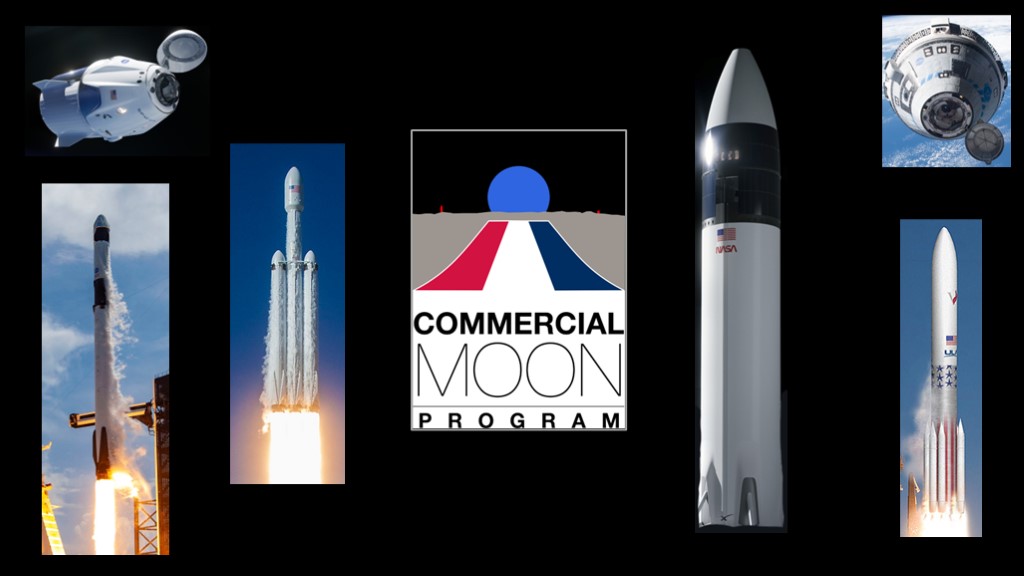
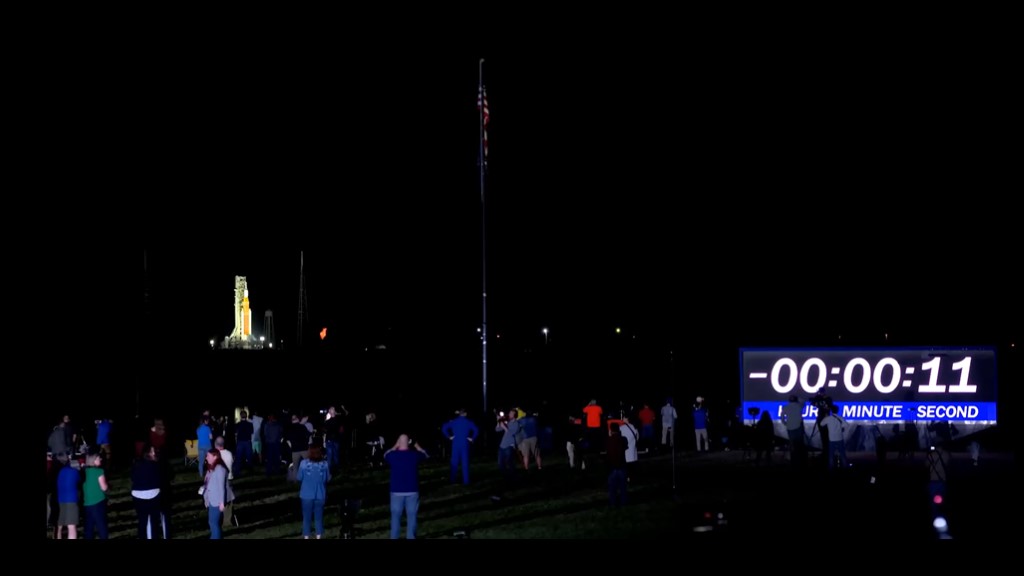

The 2022 launch of Artemis 1 has shown that NASA is on track for being able to send astronauts to lunar orbit using the SLS launcher and Orion Capsule, a key part of the artemis lunar strategy. Next up will be Artemis 2, a trip with astronauts around the moon in 2024, and finally, the first lunar surface mission, Artemis 3 in 2025.
The lander for the lunar surface is a variant of SpaceX's starship vehicle, and obviously it needs to be ready for Artemis 3 or there is no lunar surface mission. There will also be a test flight of starship before putting crew on it that occurs sometime before Artemis 3.
After that, there are future flights for the remainder of the decade, with flights in 2027, 2028, and 2029, using either starship or an alternate lander. It's a slow cadence

Meanwhile, SpaceX has built a starship factory at Boca Chica, Texas that can produce one starship per month, and they have a completed launch site nearby.
If that weren't enough, they are very quickly building a second starship factory at their Roberts Road site at Kennedy Space Center and have already completed a starship launch tower at pad 39A where they currently launch Falcon 9 and Falcon Heavy.
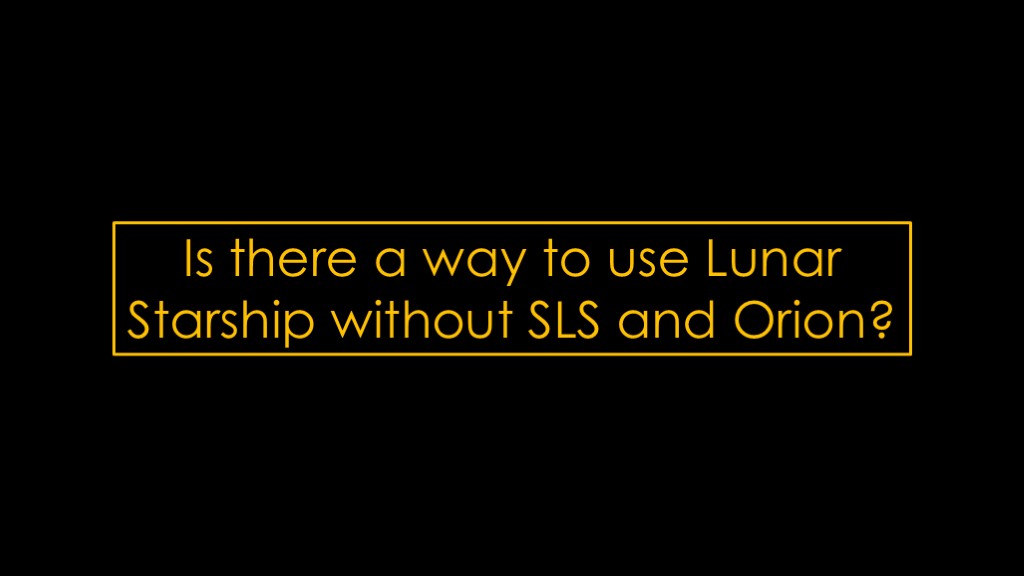
Which brings up a very obvious question. If SpaceX has the capability to build lunar starships more quickly than SLS and Orion can launch, is there a way to use lunar starship without SLS and Orion?
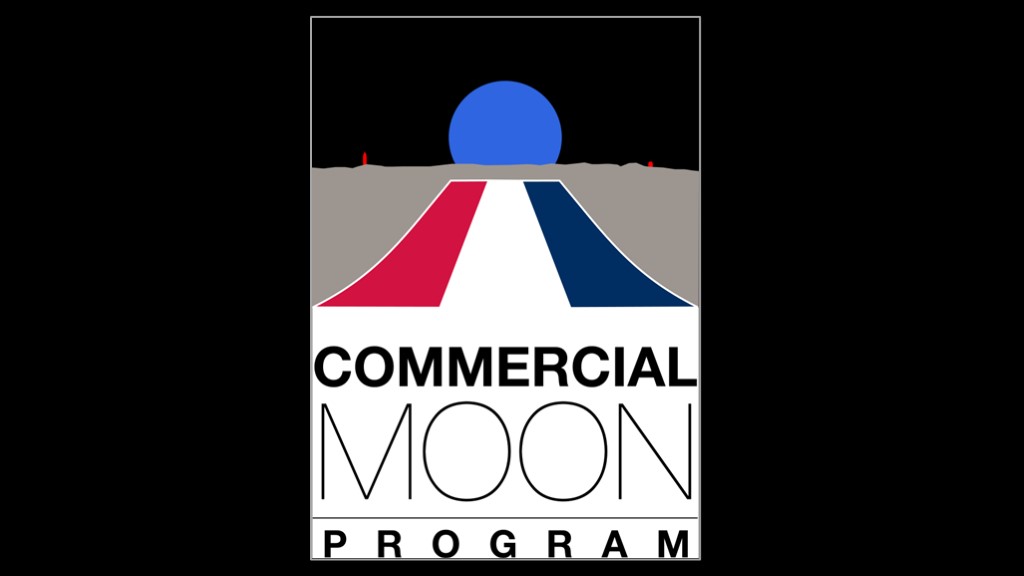
This is commercial moon...
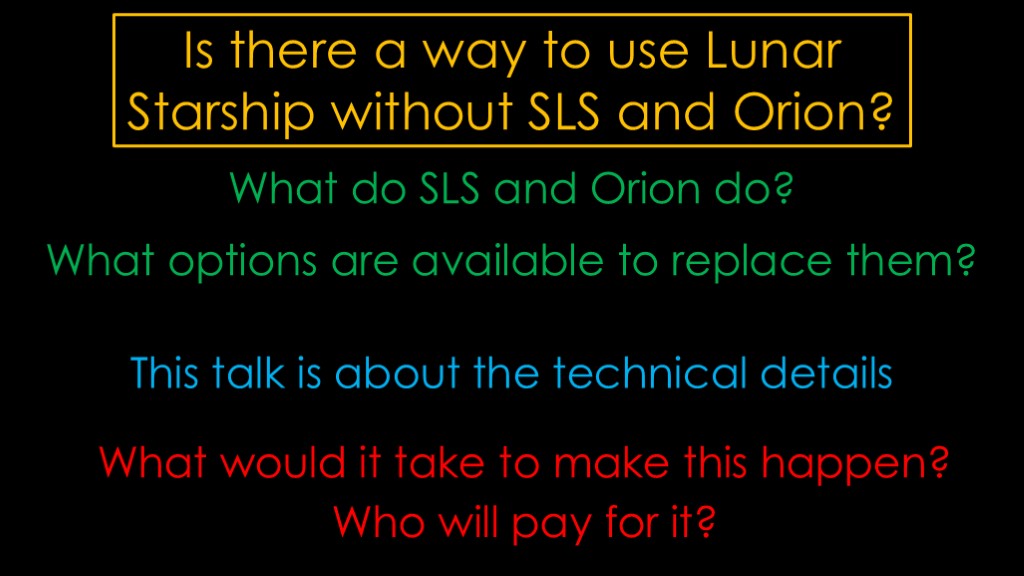
To answer our question, we'll need to dig into the details of what SLS and Orion do and then talk about different options that we might use to replace them.
This talk is about the technical details - I will not, for example, talk about what it might take to make it happen in the current political environment or who might pay for it.

We'll start by looking at the current Artemis architecture. If you want more details, see my video unsurprisingly titled "artemis architecture".
The first step is to launch lunar starship into a low earth orbit, and then fly enough tanker flights to refuel it.
Starship then relights its engines to send it out of low earth orbit and to the earth moon transfer point, where the moons gravity will take over. Starship will then use its engines to get into a near rectilinear halo orbit around the moon. There it will sit and wait.
SLS is then used to launch the Orion capsule with 4 astronauts to the earth moon transfer, and then Orion uses its engines to get into the same near rectilinear halo orbit as starship.
They dock, and two astronauts transfer to starship.
Starship lands on the surface, time passes, they come back up from the surface, get back in Orion, and orion uses its engines to get out of lunar orbit and head for home.
At that point there's an empty lunar starship left in Near rectilinear halo orbit.
I call this approach the artemis reference architecture.
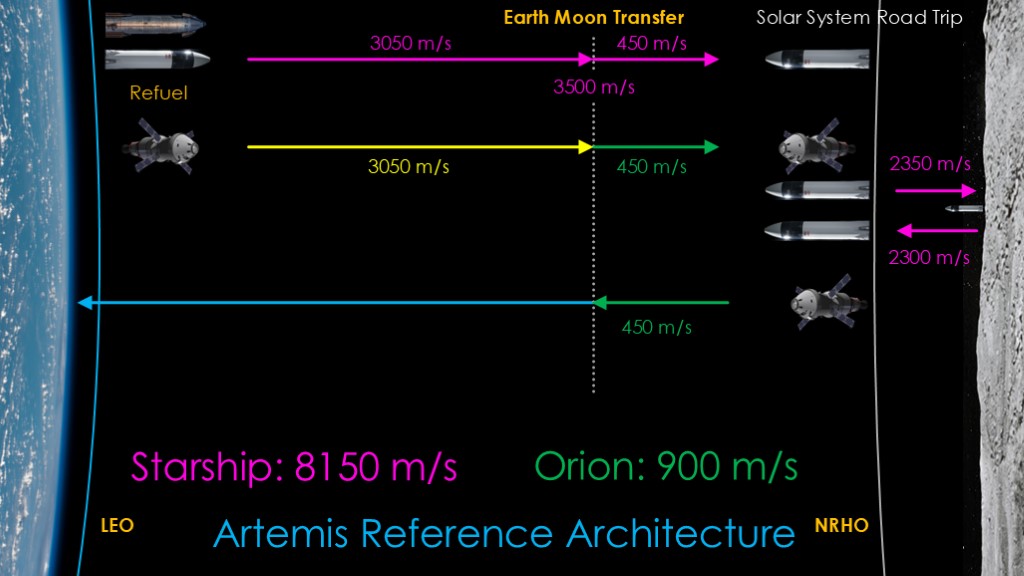
Our options in space are controlled by the energy cost - what we often call the delta v cost. See my solar system road trip video for more information on delta v.
Let's add some labels to our chart to indicate how much delta v we need for each part of the journey. All of these numbers are estimates.
Starting with starship:
It takes 3050 meters per second of delta v to get from low earth orbit to a lunar transfer orbit, and an additional 450 meters per second to get into the near rectilinear halo orbit, for a total of 3500 meters per second of delta v.
Based on Apollo numbers, it will take about 2350 meters per second to get down to the moon and 2300 meters per second to get back up.
SLS generates 3050 meters per second to toss orion to the transfer point, and Orion generates 450 meters per second to brake into the near rectilinear halo orbit, and the same 450 meters per second to get out.
Add all of those up, and we find that starship needs about 8150 meters per second of delta v. This architecture is *really* hard on the landers. Orion requires 900 meters per second.
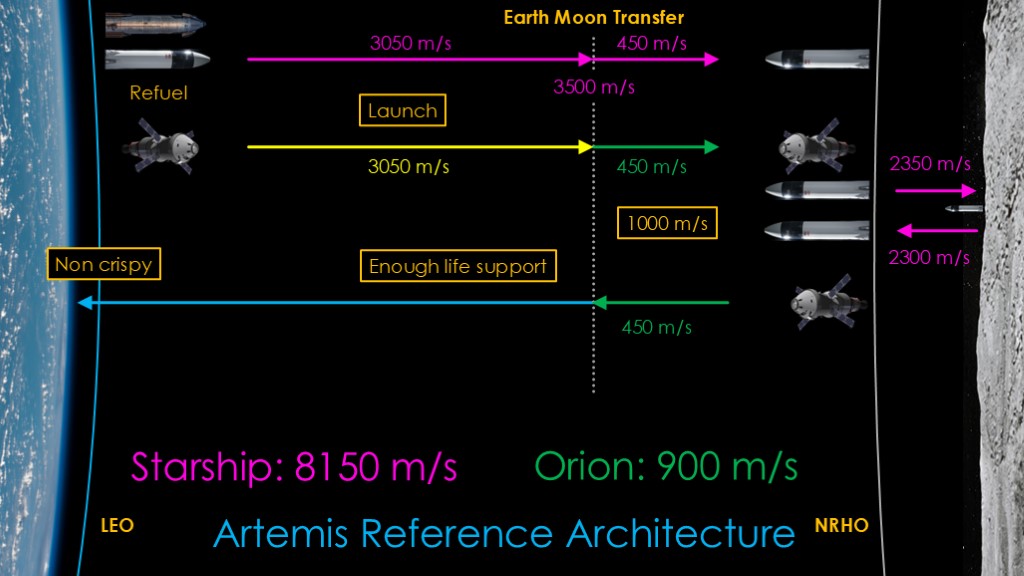
With that information, we can start exploring architectures that do not rely on SLS and Orion.
To do that, we will need to replace all of the things that SLS and Orion do.
There are three major requirements for an orion replacement.
First, it must have enough delta v to get into lunar orbit and out of lunar orbit, which I'll call 1000 meters per second.
Second, it has to have a robust enough heat shield so that it can reenter the earth's atmosphere at lunar return speeds and keep the interior from getting crispy at energies that are over twice the amount generated returning from low earth orbit.
Third, it must have enough life support to keep the crew alive for the time that they are in the capsule.
We will also need a way to get it to the earth-moon transfer point.
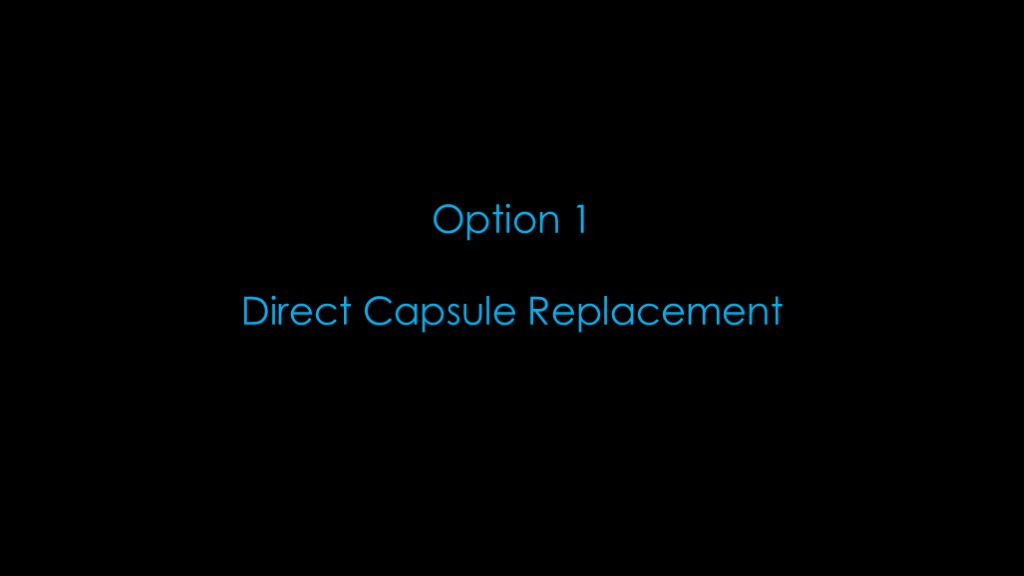
In our first option we will stick to the same architecture but replace both SLS and Orion with other options.
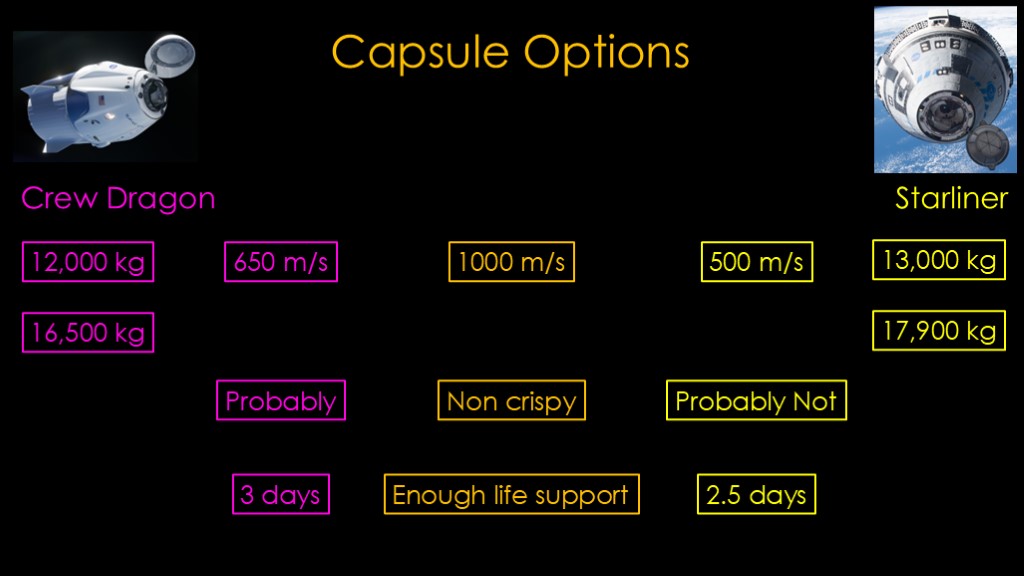
Capsules are very complicated and expensive to develop, so we'll need something that's either in service or close to going into service.
That limits us to two options, either SpaceX's crew dragon, or Boeing's Starliner. Both are designed to carry crew to the international space station, so they weren't really designed for this sort of mission.
Let's see how they stack up against our requirements.
We need 1000 meters per second of delta v. I was unable to find good numbers, but it appears that crew dragon has about 650 meters per second of delta v *if* you are willing to use the SuperDraco abort motors. Starliner looks to be around 500 meters per second, but some of that might be used to put the capsule into orbit.
To reach our 1000 meter per second goal will require modifications to carry more fuel. This would require a larger service module for starliner, and spacex would need to figure out a way to carry fuel in the trunk. Crew dragon masses about 12,000 kilograms at launch, and starliner masses about 13,000 kilograms. If we need to add 1000 m/s of delta v to their thrusters, we end up around 16,500 kg for crew dragon, 17,900 for starliner.
These are both in the "doable, but require some serious work" category.
Looking at heat shields, dragon is supposedly designed to deal with reentry speeds from lunar orbit, and the starliner heat shield is probably only intended to deal with earth orbit reentry, so it would need to be upgraded.
Looking at life support, the inspiration 4 flight of crew dragon lasted 3 days, and starliner is specified for 60 hours.
That's roughly half of what you need to get to the moon and back, but those numbers are with 4 crew members.
If we are okay limiting ourselves to 2 crew members, that bumps those numbers to 6 days and 5 days. That's in the right ballpark for a lunar mission.
If you can solve the delta v issue and add a bit of life support endurance, Crew Dragon looks viable. Starliner requires more work because of the heat shield, but it also looks possible.
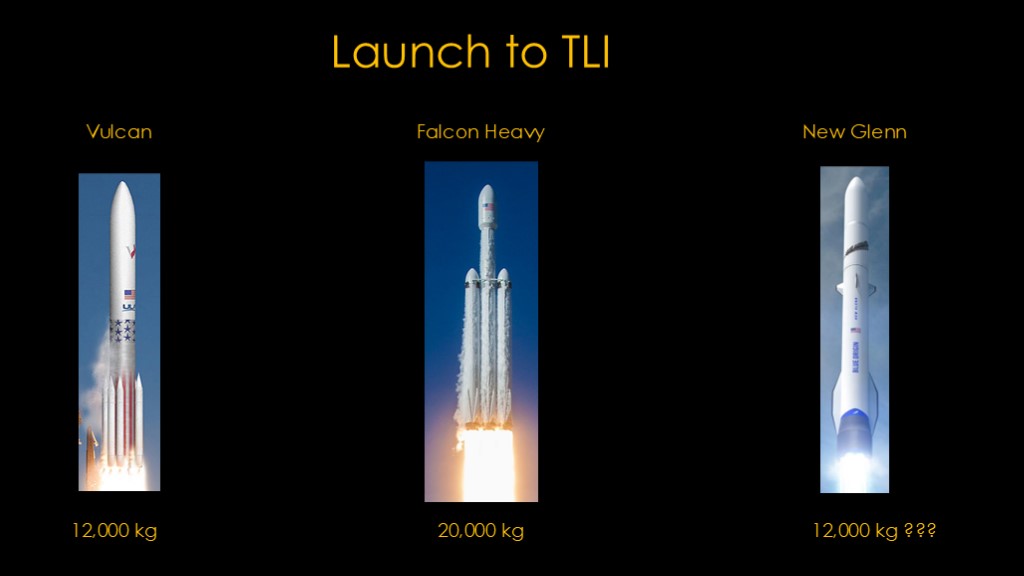
Looking at possible launchers, our choices appear to be Vulcan, Falcon Heavy, and New Glenn.
Falcon Heavy can toss around 20,000 kg to the lunar transfer point. ULA's Vulcan rocket can only do about 12,000 kilograms, and Blue Origins upcoming New Glenn is likely pretty close to that.
Given what the modified capsules would mass, Falcon heavy looks like the only practical choice. And it still will probably be tight.
Falcon Heavy is not crew rated but is based on the Falcon 9 which is crew rated.

This option looks viable, you can probably replace SLS and orion with an enhanced version of either capsule, but it would require some reengineering, with the added fuel being a significant obstacle.

Our next option is one I'm calling "A blast from the past"
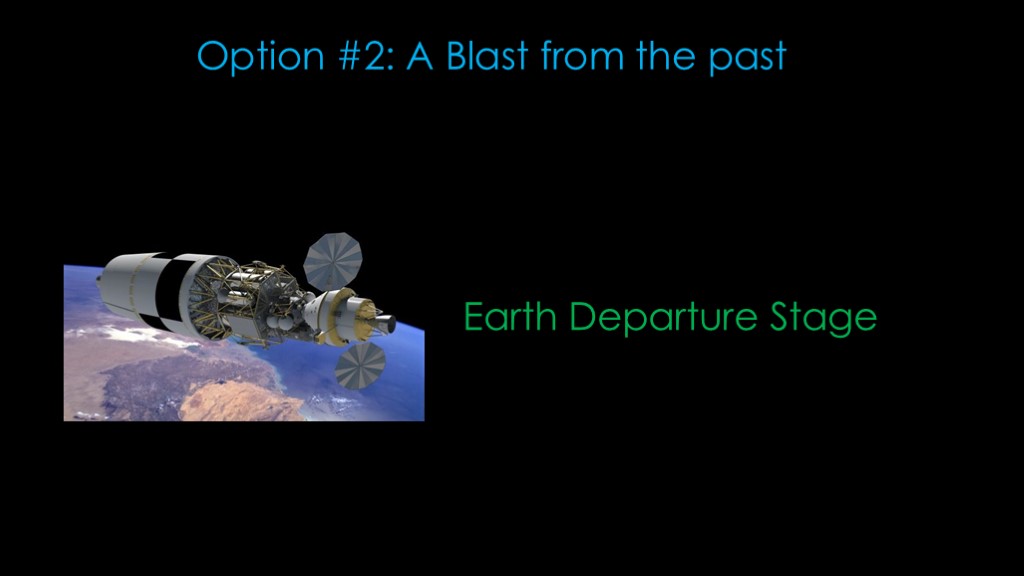
The constellation program from the early 2000s was targeting low lunar orbit, and the orion design did not have enough delta v to get into that orbit and back out of it.
One of their architectures used an Earth Departure Stage to do the work of getting Orion out of low earth orbit and into low lunar orbit, and that gave orion enough delta v to get out of low lunar orbit and back to earth at the end of the mission.
Can we do something similar?

This approach has a lot of allure, because we already have two crew-rated launchers, and not doing crew rating for Falcon Heavy makes things easier.
But can we launch the heavier versions of the capsules that will be required for Lunar Missions?
The Falcon 9 part is pretty easy; it can launch 16,600 kg in reusable mode, and up to 22,800 kg in expendable mode.
The Atlas V is a bit harder; the highest payload for the Atlas V is 18,850 kg, which would probably work, but that's pretty close the how much the lunar starliner might weigh.

However, there aren't any available Atlas V rockets anyway, so for this mission, Starliner would need to launch on ULA's Vulcan, which can do up to 27,200 kg to low earth orbit.
Or starliner could launch on Falcon 9 as it can fly on different launch vehicles.
Get the heavier capsules into low earth orbit will not be a problem.
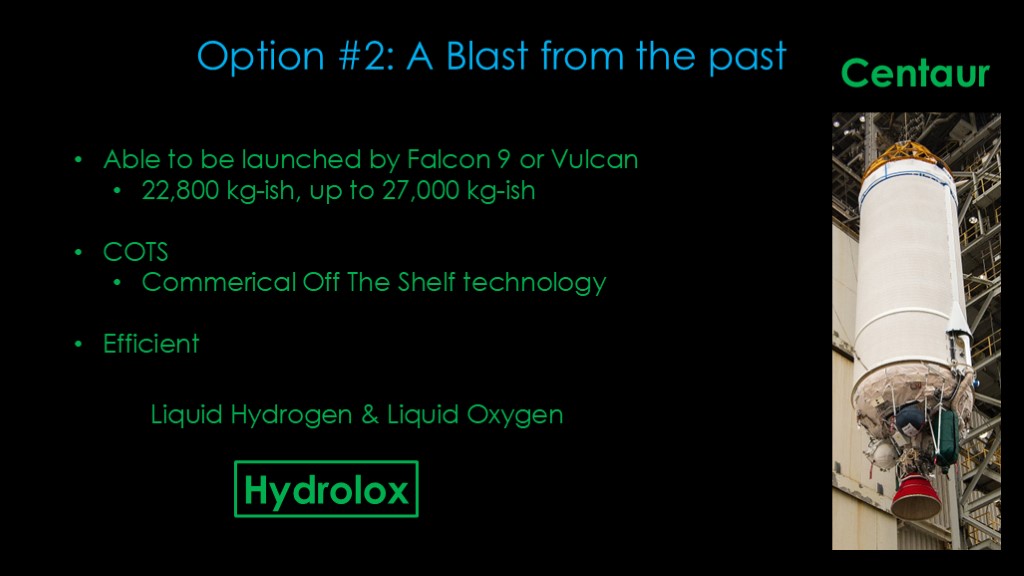
Now we need a departure stage. Here's a small list of requirements:
First, it needs to be within the payload capacity of Falcon 9 or Vulcan. That means 22,800 kg for Falcon 9, up to 27,000 kg if we want to use Vulcan. Vulcan Heavy could be an option if we found something heavier.
Second, it needs to be COTS, or commercial off the shelf technology. No sense in spending a ton of time and money to create a new stage.
Third, it needs to be efficient - we don't have much payload and we need a lot of delta v out of it.
The efficiency requirement means we'll need to chose a liquid hydrogen and liquid oxygen, or hydrolox engine. This sort of mission is where hydrolox shines.
There's really only one active US hydrolox stage, and that's Centaur.
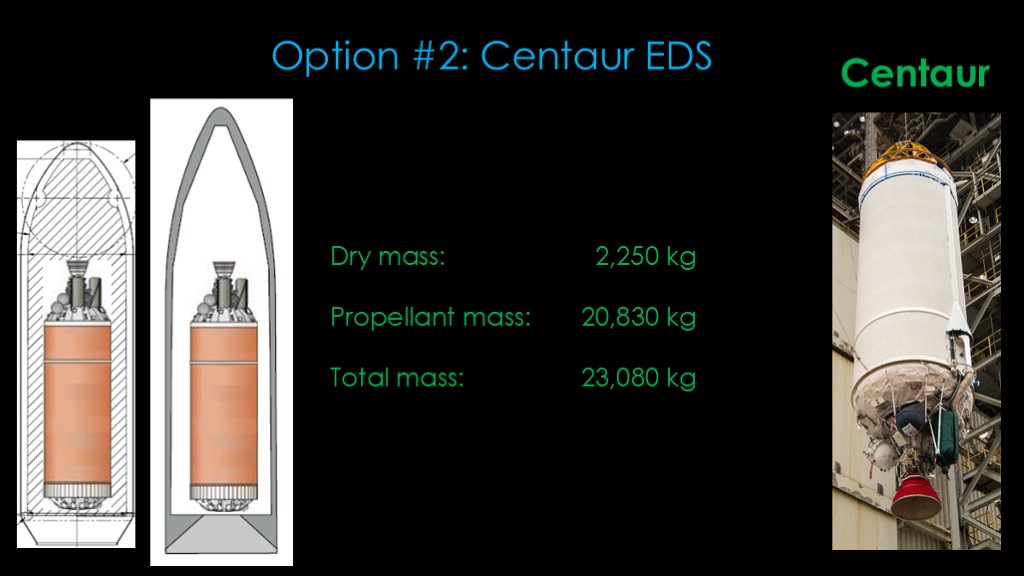
Centaur turns out to be a great choice.
It has a dry mass of only 2,250 kilograms, and a propellant mass of 20, 830 kilograms. That gives it a total mass of 23,080 kilograms, just 280 kilograms more than the maximum payload of the Falcon 9 and well within the maximum payload of Vulcan. Cut down the propellant just a bit, and it will launch on either Falcon 9 or the cheaper variant of Vulcan with only four solid rocket motors.
It fits inside of the Falcon 9 extended fairing and the large Vulcan fairing. It might sneak into the short Vulcan fairing, but the clearances look tight.
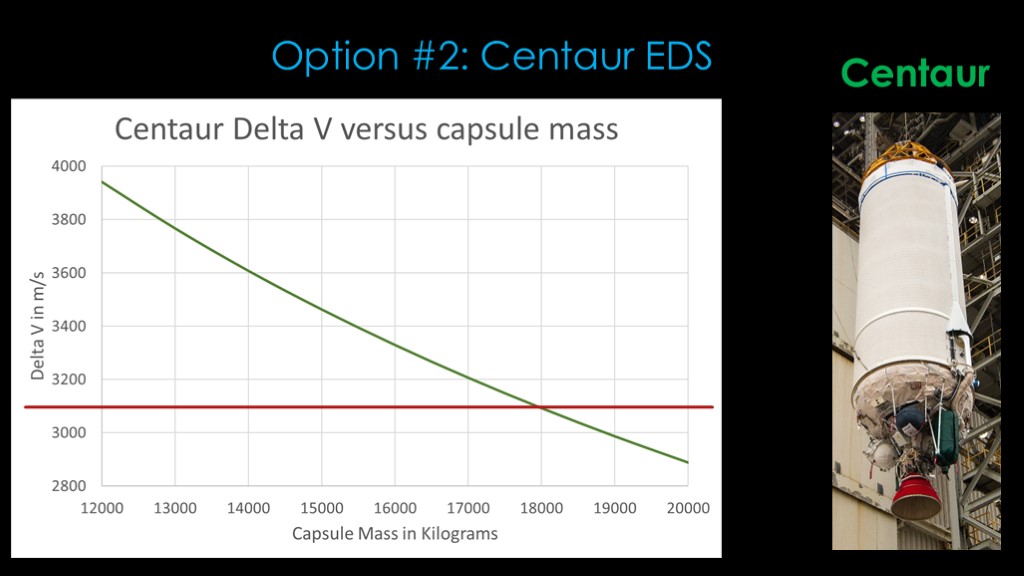
How much delta v can we get out of centaur pushing one of our heavy capsules?
Here's a chart that shows the delta v for centaur with different capsule masses.
I'll add a line at 3100 meters per second of delta v as that is what it takes to get from low earth orbit to the earth moon transfer point.
We see that we can get 3100 meters per second of delta v even if the capsule has a mass of 18,000 kilograms.
Given the masses that we figured for the capsules, this option looks good for crew dragon, but marginal for starliner because of the new heat shield requirement.

The mission is similar to the reference approach.
Centaur is launched first, then crew dragon. They dock, and then centaur gives crew dragon enough of a push to get it to the earth moon transfer. Dragon gets into lunar orbit and then gets out when it needs to head back to the earth at the end of the mission.
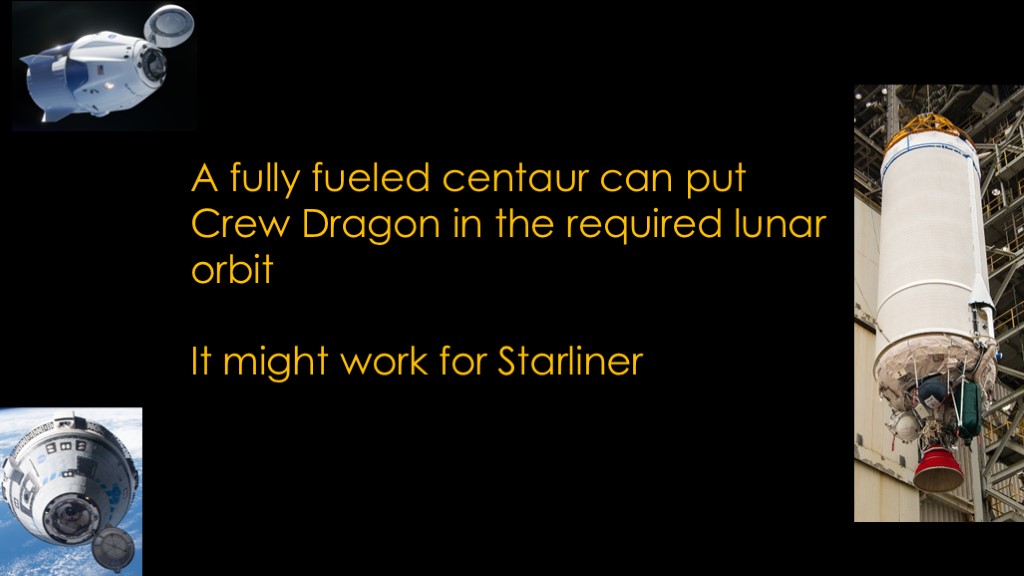
It turns out that Centaur is coincidentally the perfect size for this approach, and it can put crew dragon into the required orbit.
It might also work for starliner.

Option 3 tries to leverage the unique capabilities of starship.
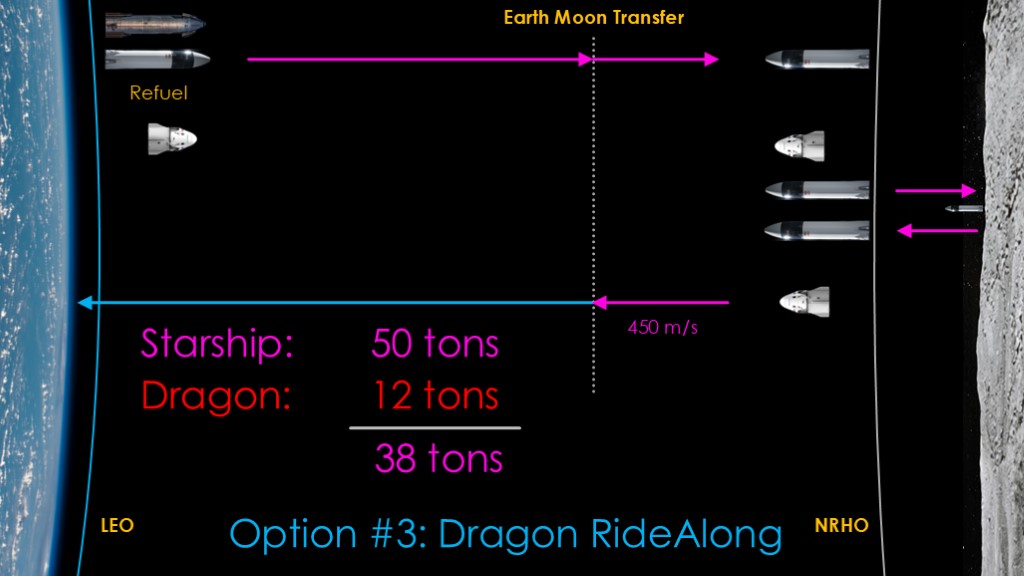
Here's how it works:
We launch our crew on dragon into orbit, and then stash the dragon inside of the lunar starship. Or perhaps docked on the front.
Starship will drop off the dragon in lunar orbit, and after the surface expedition, the crew will get in dragon for the trip home.
This approach has a significant advantage in that dragon only has to supply the 450 meters per second of delta v to get out of lunar orbit and the life support only has to last for the trip home. If the SuperDraco abort motors could be repurposed, the current version of crew dragon might be capable of doing this with minimal modifications. Starship would also need to be modified to either carry dragon internally or to be strong enough to take the stress of a dragon hanging out on the nose.
There is a downside. Lunar starship is nominally specified to carry 50 tons to the lunar surface, but it needs to carry the 12 ton dragon as well, so that reduces the net payload to 38 tons. It would be lower than that if starship cannot carry a full 50 tons.
On the other hand, the NASA requirement for the HLS landers was about 1 ton to the lunar surface, so starship provides many times that.
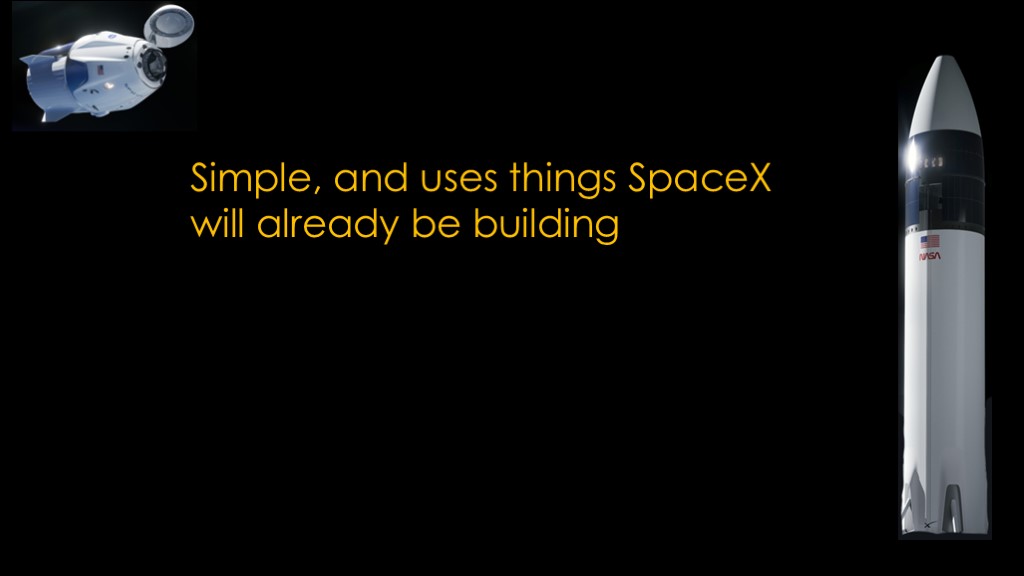
This option is simple, and uses things SpaceX will already be building.
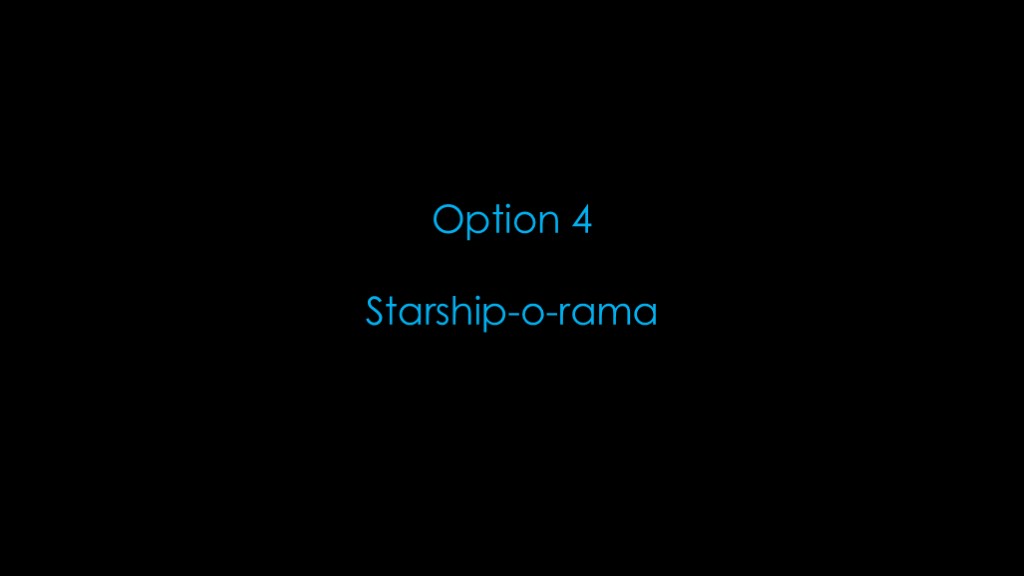
And finally we get to Option 4, Starship-o-rama
The goal is to do the mission relying only on Starship.
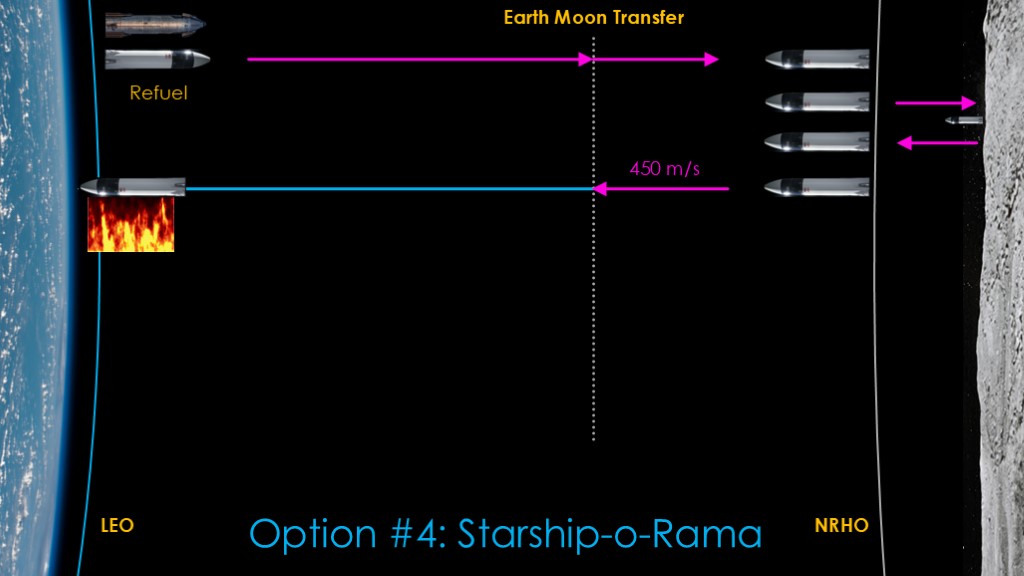
Can we just bring lunar starship back home?
There are two big obstacles.
The first is that we don't have 450 meters per second of delta v to get out of orbit, but even if we did, lunar starship doesn't have the heat shield and fins that would allow it to reenter earth's atmosphere. That would be a non-starter.
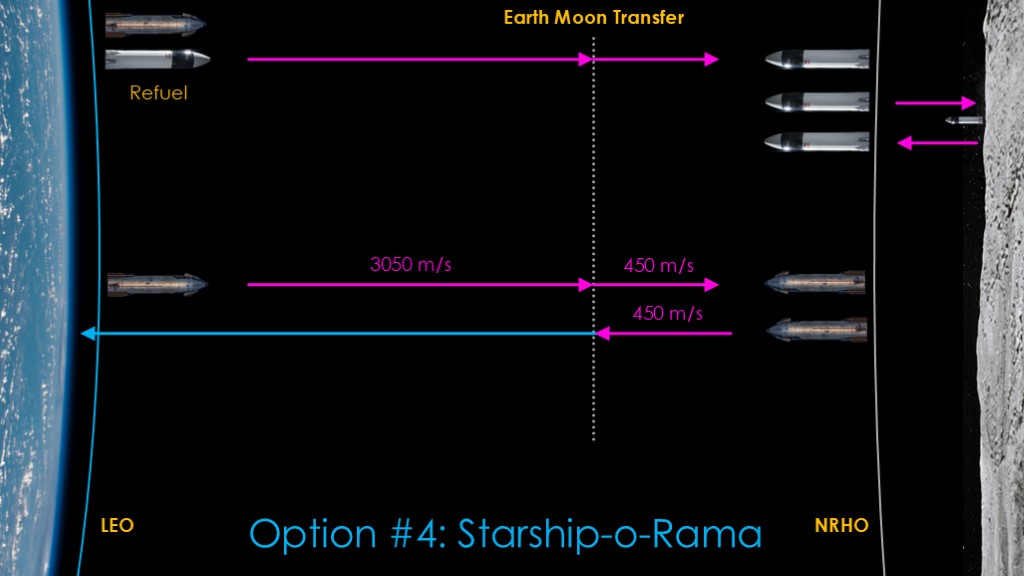
But there may be a way to make this work.
We can fuel up a normal starship so that it has 4100 meters per second of fuel, and it will have enough delta-v to get into lunar orbit to pick up the astronauts, get out of lunar orbit, and then come back and land on the earth. That's assuming the starship heat shield can handle lunar return velocities. If so, that's pretty straightforward, and 4100 meters per second only takes about 35% of a full fuel load, so it's fairly straightforward.
It does, however, still require a new lunar starship for every mission.
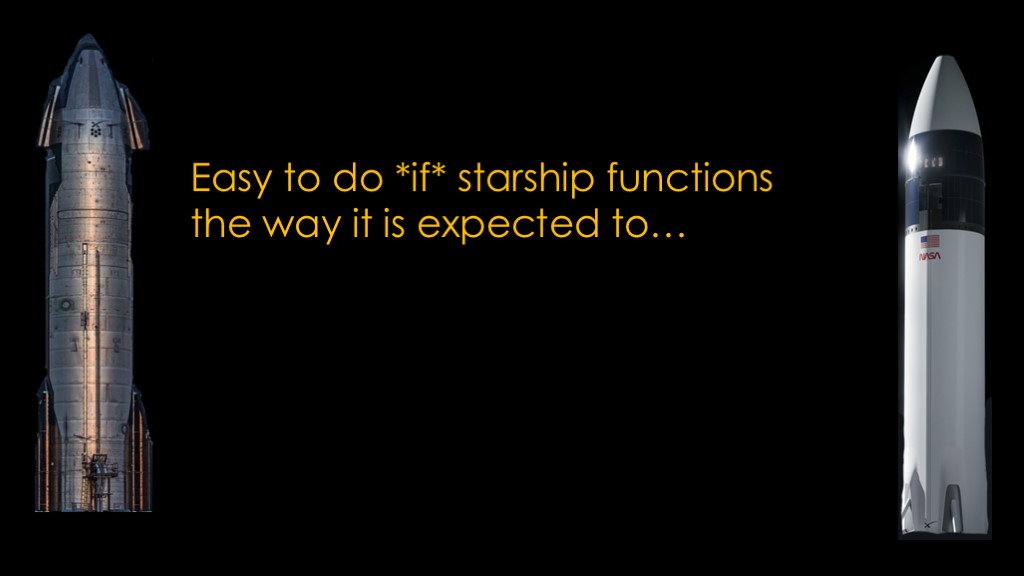
This approach is easy to do if starship functions the way it is expected to
It does - obviously - require putting crew on starship both for launch and reentry
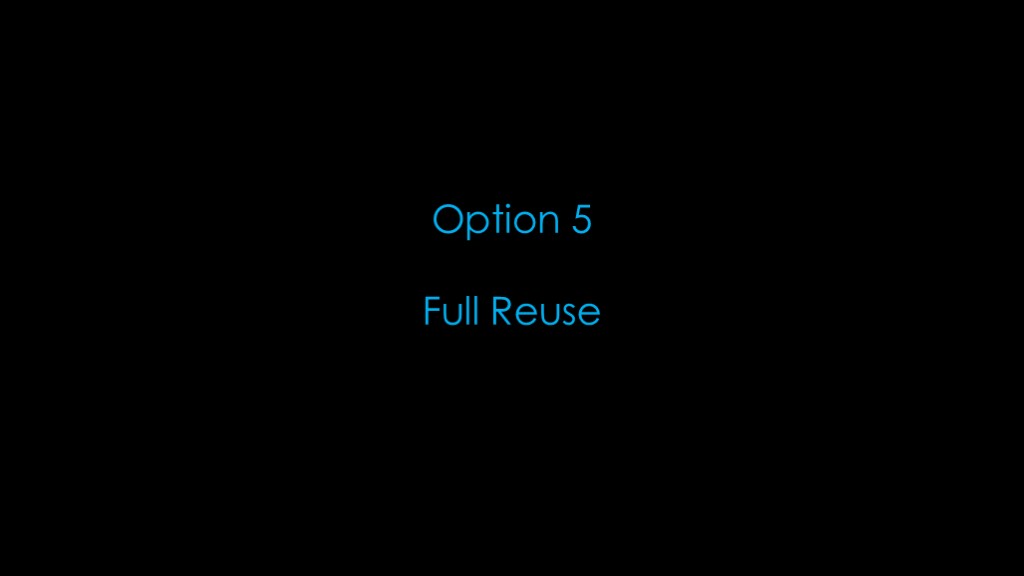
And finally to option 5, full reuse.
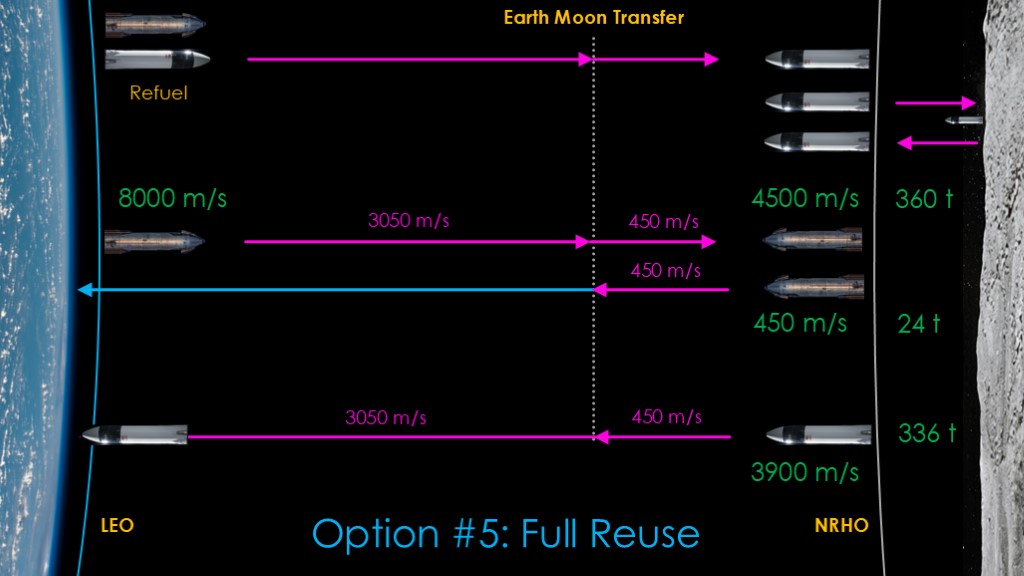
To do this we'll need to get clever about getting lunar starship back to low earth orbit.
If we take the retrieval starship from option 4 and stuff it full of fuel with minimal payload, it will have around 8000 meters per second of delta v. The trip to lunar orbit takes 3500 meters per second leaving 4500 meters per second. That's about 360 tons of fuel.
To get it back to earth will take 450 meters per second, which is surprisingly only 24 tons of fuel. That leaves us with 336 tons of fuel.
Stuff that in the empty lunar starship and that yields 3900 meters per second of delta v, which is enough to get it out of lunar orbit and to brake it gently back into low earth orbit. It's the inverse of how lunar starship got to the moon.
You have multiple choices for crew.
Option 5A puts them in starship for the whole trip. Option 5B uses dragon to get them into low earth orbit and back home.

For this approach, it appears that full reuse is within the capabilities of starship.
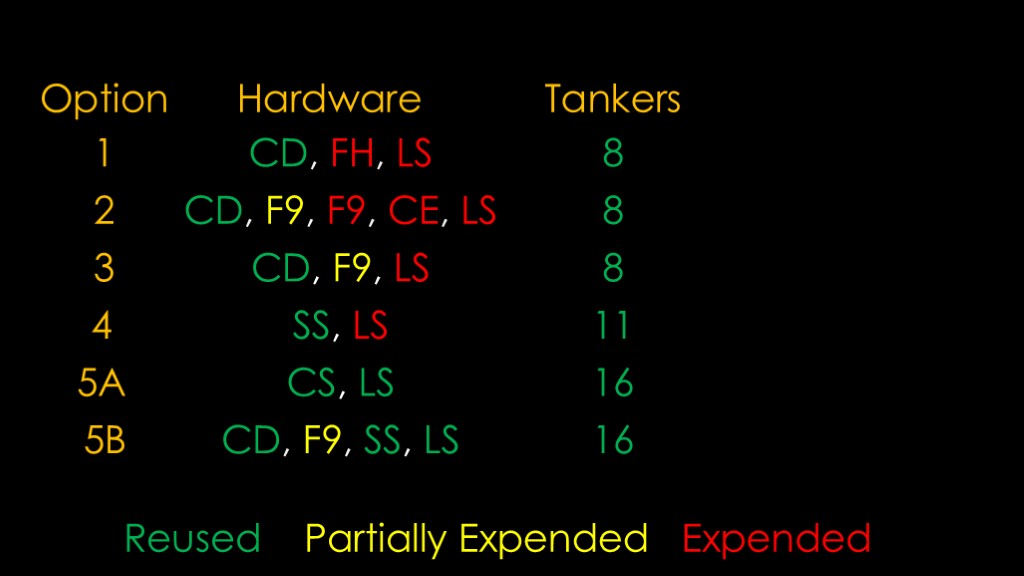
Let's summarize the logistics required for each of these options. I'm going to stick with the dragon ones but remember that there may be starliner options.
Note that hardware might be reused, it might be partially expended, or it might be fully expended. See the color code at the bottom.
Option 1 - direct capsule replacement - requires 1 modified crew dragon, 1 falcon heavy, and 1 lunar starship. It also requires 8 tanker flights to refuel lunar starship (that number might be different)
Option 2 - the centaur variant - requires 1 modified crew dragons, 2 falcon 9, 1 centaur, and 1 lunar starship
Option 3 - ride along - requires 1 crew dragon, 1 falcon 9, and 1 lunar starship
Option 4 - starship o rama - requires an normal starship, a lunar starship and 3 extra tanker flights to give it enough fuel.
Option 5A - full starship reuse - requires 1 crew starship and one lunar starship. It also requires 16 tanker flights
And Option 5B - full starship reuse but using capsules - requires a crew dragon, a falcon 9, a starship, and a lunar starship
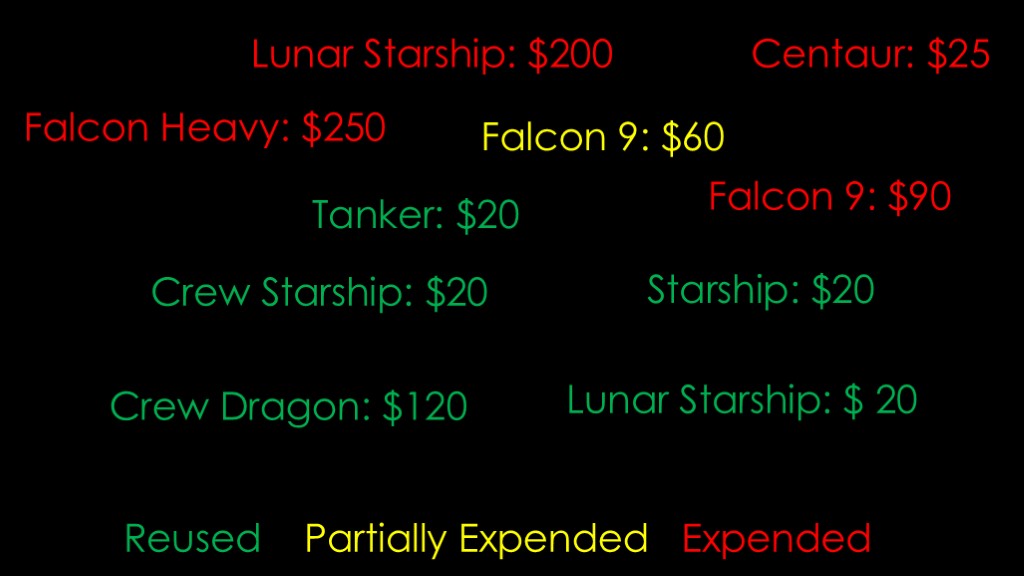
I came up with some prices for my model.
This is not the way to do this - numbers should be better researched and should factor in launch rate. And they probably should include research and development as well.
But I did it anyway because I know that people want numbers. Just note that these numbers are all wrong, some slightly wrong, some significantly wrong.
And they are intended to be *prices* rather than *costs*
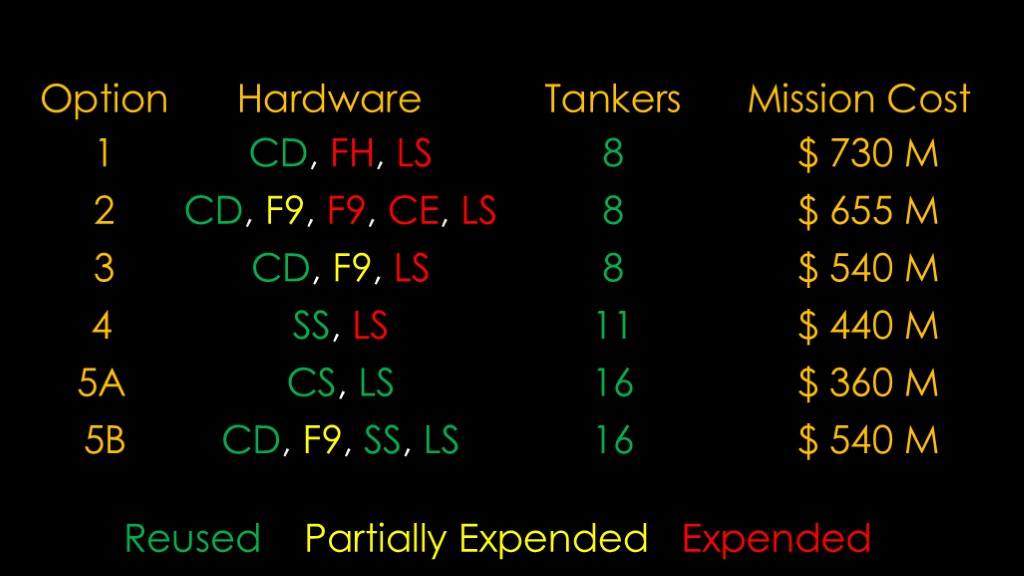
Plug those numbers in and here's what you get - somewhere between $300 and $800 million for all the options.
I'm not going to talk about them in detail because it's really easy to push the numbers around with different assumptions. If you want to play with the numbers, let me know and I'll send you my spreadsheet.
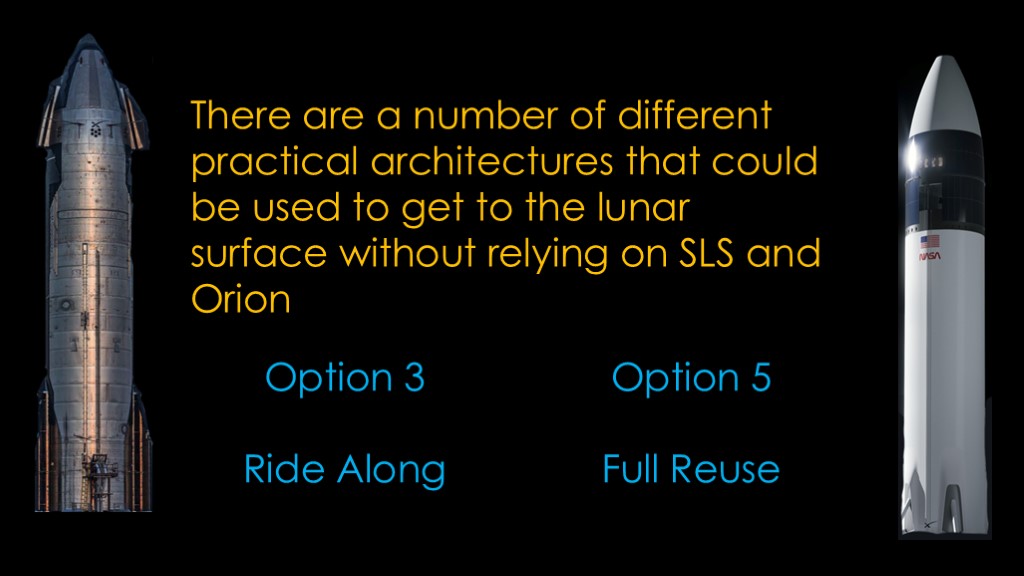
Thanks for your attention.
In summary, there a number of different practical architectures that could be used to get to the lunar surface without relying on SLS and Orion, and they're reasonably affordable.
If I had to choose one, for the short term it would be option 3, ride along. It can probably be done with the least amount of work.
The full reuse of option 5 looks best for the long term

If you enjoyed this video, please draw me a picture of a centaur riding a centaur.